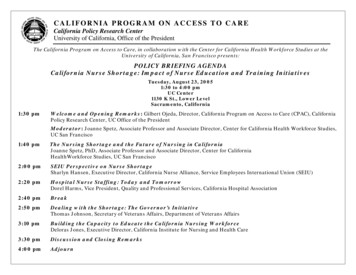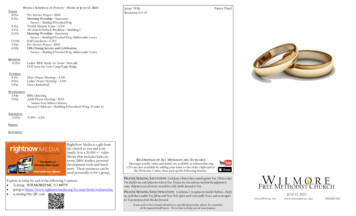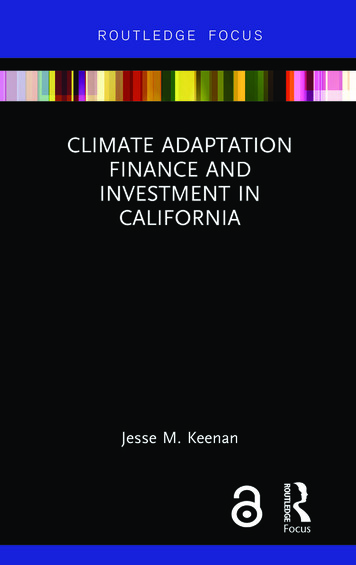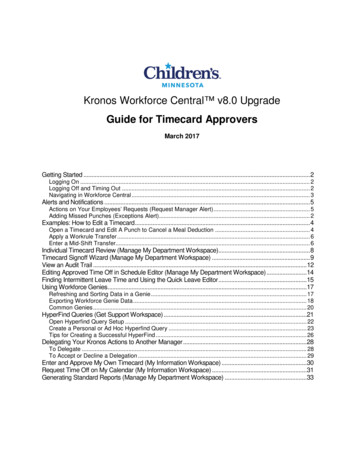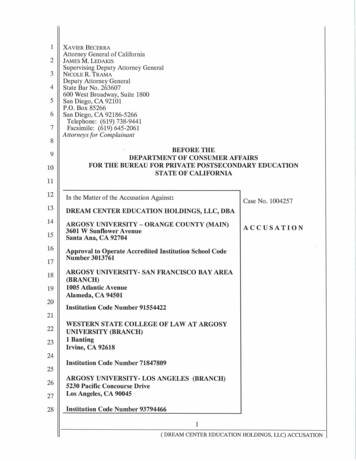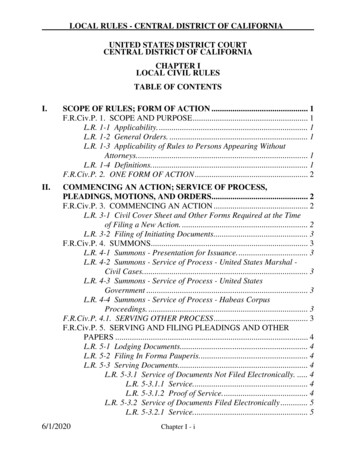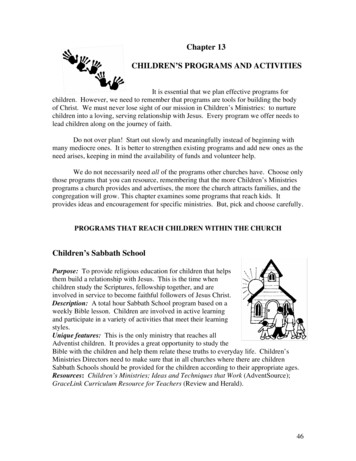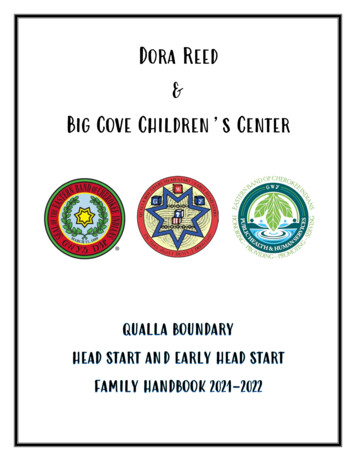
Transcription
CENTRAL CALIFORNIA CHILDREN’S INSTITUTEThe Central California Children’s Institute is dedicated to improving the well-being and quality of life for all children,youth, and their families in the Central California region. The objectives of the Central California Children’s Institute areto (a) study health, education, and welfare issues that affect children and youth in the Central California region; (b)provide an informed voice for children and youth in the Central California region; (c) develop policy and programs, andfoster communication and collaboration among communities, agencies, and organizations; and (d) enhance the qualityand effectiveness of communities, agencies, and organizations that provide services to children, youth, and their families.Additional information about the Central California Children’s Institute, its programs and activities, including this report, health-related calendar, and academic as well as community resources may be found at http://www.csufresno.edu/ccchhs/CI/.Central California Children’s InstituteCentral California Center for Health and Human ServicesCollege of Health and Human ServicesCalifornia State University, Fresno1625 E. Shaw, Suite 146Fresno, CA 93710-8106559-228-2150Fax: 559-228-2168This report may be downloaded from http://www.csufresno.edu/ccchhs/CI/SUGGESTED CITATIONRondero Hernandez, V., Sutton, P., Curtis, K. A., & Carabez, R. (2004). Struggling to breathe: The epidemic of asthmaamong children and adolescents in the San Joaquin Valley. Fresno: Central California Children’s Institute, CaliforniaState University, Fresno.COPYRIGHT INFORMATIONCopyright 2004 by California State University, Fresno. This report may be printed and distributed free of charge foracademic or planning purposes without the written permission of the copyright holder. Citation as to source, however, isappreciated. Distribution of any portion of this material for profit is prohibited without specific permission of thecopyright holder.2
AcknowledgmentsAcknowledgmentsThis publication would not have been possible without the assistance of the following individuals. We express ourappreciation to each of them.Research SupportRaj BadheshaConnie CuellarShelley HoffAntony Martin JoyAshley SicklerPhotographyKathleen Curtis, PT, Ph.D.Donna DeRooThe California EndowmentAdi SusantoGraphic DesignBecky Ilic - Media Cube DesignLeadership and Project SupportCarole Chamberlain, Program Officer, The California EndowmentLeeAnn Parry, Community Benefits Manager, Kaiser Permanente Central California Service AreaBenjamin Cuellar, Dean, College of Health and Human Services, California State University, FresnoJeromina Echeverria, Provost and Vice President for Academic Affairs, California State University, FresnoRegional Advisory Council, Central California Children’s InstituteThis study was funded by a grant from The California Endwoment. The printing of this report was provided by KaiserPermanente Central California.3
ExecutiveExecutive Summary SummaryAsthma is a serious and growing epidemic that disproportionately affects school-age children in the San Joaquin Valley.Over 1 million children live in the eight San Joaquin Valley counties (Fresno, Kern, Kings, Madera, Merced, San Joaquin,Stanislaus, and Tulare). An estimated 157,000 (15.8%) children and adolescents ages 0-17 in the San Joaquin Valleyhave been diagnosed with asthma.The high prevalence of asthma in San Joaquin Valley communities makes ongoing surveillance of critical importance todetect and manage this chronic health condition. Currently, asthma is not a reportable public health condition, making itdifficult to monitor its prevalence and produce precise data for local communities. Results from the 2001 CaliforniaHealth Interview Survey (2001 CHIS) have helped compensate for the historical absence of detailed regional and localsurveillance data. Data are presented to inform policy-makers, agencies, organizations, and communities concernedabout this chronic condition and its effect on the health and well-being of children and adolescents, their families, andtheir communities.Disparities in Asthma Prevalence and ManagementThe results of the 2001 CHIS indicate that there are differences or disparities in the prevalence of asthma and asthmasymptoms among children by age, gender, ethnicity, income level and place of residence. For example, the data examinedin this report show that asthma is slightly more common among boys than it is among girls, as 60% of children who havebeen diagnosed with asthma in the San Joaquin Valley are boys. However, among all children diagnosed with asthma,girls, especially adolescent girls ages 12-17, experience asthma symptoms more frequently than do boys.Asthma is more common among African American and American Indian children than it is among Latino, Asian or Whitechildren in the San Joaquin Valley. Over 1 in 3 African American and American Indian children have been diagnosed withasthma, compared with 1 in 6 White children, 1 in 8 Latino children, and almost 1 in 10 Asian children. Where childrenlive also seems to be a factor in asthma diagnosis. Rates of asthma are highest among children who live in Fresno andKings Counties, where over 20% of children ages 0-17 have been diagnosed with asthma, compared with 15.8% Valleywide.The Costs of AsthmaOur health, educational, social, and family systems all bear the costs of asthma. Asthma-related costs include health carefor asthma management, local revenues lost through decreased school attendance, and disruptions in daily routines thatmay affect the employment, income, and quality of life of families of children diagnosed with asthma. Over half of all SanJoaquin Valley children and adolescents diagnosed with asthma, an estimated 87,000 children, take medication to controlasthma symptoms. Even with medication, 6 in 10 of these children experience asthma symptoms once a month or moreoften. San Joaquin Valley children and adolescents with asthma report an estimated 25,000 emergency department visitsand 4,000 hospitalizations annually. Public, private and local sources all bear these health care costs.Local school districts lose revenue due to asthma-related student absences. One third of adolescents diagnosed withasthma miss one or two days of school every month. Based on statewide estimates, with 11.5% of school-age childrenliving in the San Joaquin Valley, the conservative estimate of the Valley’s annual school absenteeism due to asthma totals808,000 absences, accounting for lost revenue to regional school districts of at least 26 million annually.The findings of this report underscore the urgency of finding viable solutions for San Joaquin Valley communities. Thefuture for children with asthma in the San Joaquin Valley remains uncertain. Considering that the San Joaquin Valley hasthe highest prevalence of childhood asthma in the state, Valley policy-makers, health, education, and social serviceproviders must address environmental policy as a priority. Their collaborative efforts must identify and provide neededcare for children and adolescents with asthma, as well as monitor and reduce related school absences, emergency roomvisits, and hospitalizations. The future of our children and the San Joaquin Valley depends on it.4
TableTable of Contentsof ContentsCentral California Children’s Institute. 2Acknowledgments. 3Executive Summary. 4List of Figures. 6List of Tables .7Methodology. 8Facts About Asthma. 9Characteristics of the San Joaquin Valley. 12Asthma in the San Joaquin Valley. 15Summary of Findings. 27Recommendations. 29Conclusion. 30References. 315
ListList of Figuresof Figures61. San Joaquin Valley Child and Adolescent Population Ages 0-17, 2000.122. San Joaquin Valley Child and Adolescent Population Ages 0-17 as a Percentage of Total Population, 2000.123. San Joaquin Valley Child and Adolescent Population in Urban and Rural Settings, 2001.134. Race/Ethnicity of Children and Adolescents Ages 0-17 in the San Joaquin Valley, 2000.145. Frequency of Asthma Symptoms by Age Among San Joaquin Valley Children and AdolescentsAges 0-17 Diagnosed With Asthma, 2001.196. Frequency of Asthma Symptoms by Ethnicity Among San Joaquin Valley Children and AdolescentsAges 0-17 Diagnosed With Asthma, 2001.207. Frequency of Asthma Symptoms by Federal Poverty Level Among San Joaquin Valley Children andAdolescents Ages 0-17 Diagnosed With Asthma, 2001.218. Frequency of Asthma Symptoms by Place of Residence Among San Joaquin Valley Children andAdolescents Ages 0-17 Diagnosed With Asthma, 2001.229. San Joaquin Valley Children and Adolescents Ages 0-17 Who Were Diagnosed With Asthma andTake Medication to Control Asthma Symptoms, 2001.2210. Frequency of Asthma Symptoms Among San Joaquin Valley Children and Adolescents Ages 0-17Who Were Diagnosed With Asthma and Take Medication to Control Asthma Symptoms, 2001.2311. Health Insurance Coverage Among San Joaquin Valley Children and Adolescents Ages 0-17Who Were Diagnosed With Asthma and Take Medication to Control Asthma Symptoms, 2001.2412. San Joaquin Valley Children and Adolescents Ages 0-17 Diagnosed With Asthma Who Visited anEmergency Room for Asthma Symptoms and Take Medication to Control Symptoms, 2001.2513. San Joaquin Valley Children and Adolescents Ages 0-17 Whose Asthma Limits or Prevents ActivitiesThat Are Usual for Their Age, 2001.25
ListList of Tablesof Tables1. Children and Adolescents Ages 0-17 Diagnosed With Asthma, 2001.152. Children and Adolescents Ages 0-17 Diagnosed With Asthma by Age Groups, 2001.163. Children and Adolescents Ages 0-17 Diagnosed With Asthma by Gender, 2001.164. Lifetime Asthma Prevalence by Ethnicity Among San Joaquin Valley Children and AdolescentsAges 0-17,2001.175. San Joaquin Valley Children and Adolescents Ages 0-17 Diagnosed With Asthma by Family Income as aPercentage of the Federal Poverty Level, 2001.176. San Joaquin Valley Children and Adolescents Ages 0-17 Diagnosed With Asthma by Place ofResidence, 2001.187. Asthma Symptom Prevalence Among San Joaquin Valley Children and Adolescents Ages 0-17, 2001.188. Frequency of Asthma Symptoms by Gender Among San Joaquin Valley Children and AdolescentsAges 0-17 Diagnosed With Asthma, 2001.207
MethodologyMethodologyData SourcesThis report uses secondary data and prevalence estimates about asthma from the 2001 California Health InterviewSurvey (2001 CHIS; UCLA Center for Health Policy Research, 2004). The CHIS is a telephone survey of Californiacommunities that was conducted in six languages by the Center for Health Policy Research at the University of California, Los Angeles School of Public Health, between November 2000 and September 2001. Households with children ages0-17 in the San Joaquin Valley and other communities in the state were randomly selected, and telephone interviews wereconducted with the adult who had the most knowledge about the child under age 12 about whom data were being gatheredand with one adolescent age 12-17 if living in the same household. Responses to questions about asthma and other healthconditions and behaviors were collected during these interviews, and these responses were used to calculate county-levelestimates for the prevalence of asthma in the eight counties of the San Joaquin Valley. The tables and figures in this reportcontain current estimates of the extent of asthma and asthma symptoms from the 2001 CHIS.In addition, data from the U.S. Census Bureau are used to present San Joaquin Valley children’s demographic characteristics, such as number of children and their ethnicity.Data LimitationsThe 2001 CHIS was conducted using a random sample of the San Joaquin Valley population. The numbers and percentages presented in this report are therefore weighted estimates of the prevalence of asthma and asthma symptoms amongchildren ages 0-11 and adolescents ages 12-17.When relatively small numbers of survey participants are used to generate population estimates, there is always someerror introduced. To mitigate the effects of such sampling bias, CHIS researchers used special weighting procedures. Insome cases, however, the level of potential error is such that the estimate is unavailable or is considered unstable. In someinstances in this report, unstable estimates are presented along with stable estimates for the purpose of comparisonbetween groups of data. The authors recognize this limitation of the data presented and encourage the reader to usecaution in interpreting estimates and percentages identified as unstable.The authors also recognize the potential bias of the self-report data collected in the 2001 CHIS, as respondents’ subjectiveexperiences and understanding of asthma and asthma symptoms may vary. In addition, the identity and experiences ofeach respondent may introduce bias in other ways. All of the data reported for children, ages 0-11, was reported by aparent or responsible adult, not the children themselves. In contrast, the data reported for adolescents, ages 12-17, wasreported by the adolescent participant directly.8
FactsFacts AboutAboutAsthmaAsthmaAsthma is a chronic inflammatory disease of the lungscharacterized by recurrent episodes of breathlessness,wheezing, coughing, and chest tightness, termed exacerbations. The underlying cause of asthma is unknown,although medical personnel and public health professionals believe it is related to the interplay of several factors,including frequency and severity of early-life infections,genetics, diet, exposure to indoor allergens, as well as indoor and outdoor pollution (McConnell et al., 2002).Specific factors thought to trigger asthma symptoms include sinus infections, air pollution, excessive exercise,exposure to cold air, and exposure to irritants such as cigarette smoke and chemicals. Even certain emotional statessuch as fear, laughing, and crying can trigger asthma symptoms (Schwartz, 1999).The Prevalence of AsthmaAsthma is a serious and growing epidemic in Californiaand the United States, which is generally discussed in termsof lifetime asthma prevalence and asthma symptom prevalence. Lifetime asthma prevalence refers to a person being diagnosed with asthma at any time during his or herlifetime, whereas asthma symptom prevalence refers to aperson being diagnosed with asthma at any time duringhis or her lifetime and experiencing asthma symptoms atleast once in the previous 12 months.In 2002, the national lifetime asthma prevalence was estimated at 10.1% (Brown, Meng, Babey, & Malcolm, 2002).Between 1980 and 1994, the number of persons diagnosedwith asthma in the United States increased by 75%(Mannino et al., 1998), and the most dramatic rate increase occurred among young children. During this period, the number of children under age 5 diagnosed withasthma increased by 160% (Mannino et al., 1998).The lifetime asthma prevalence in California as a wholeand in many California counties is higher than the national average for most population groups (Brown et al.,2002). In California, an estimated 3.9 million people(adults and children) — 11.9% of the population — arereported to have been diagnosed with asthma (Brown etal., 2002). In addition, nearly 3 million people or 8.8% ofthe California population reported experiencing asthmasymptoms at least once a year, and nearly three-quartersof a million or 25% of those who experience asthma symptoms reported experiencing asthma symptoms every dayor every week (Brown et al., 2002).Asthma and Its Profound Impact onChildrenResearch has shown that asthma disproportionately affects school-age children (Brown et al., 2002). This report summarizes what is currently known about asthmaand its impact on the lives of children and adolescentswho reside in the San Joaquin Valley counties of Fresno,Kern, Kings, Madera, Merced, San Joaquin, Stanislaus,and Tulare. It is anticipated that this report will advancediscussion about the effects of this chronic health condition on the well-being of children and adolescents in thecounties of the San Joaquin Valley and underscore the urgency of finding viable solutions for Valley communitieswhose children and adolescents are affected by asthma.Implications based on the findings of this report are presented, as are recommendations related to disparities inasthma prevalence and management of asthma symptoms;the need for surveillance to detect, monitor, and track theprogress of care for children and adolescents diagnosedwith asthma; and environmental policy.The environmental influences on respiratory diseasein children. Research offers support in defining the relationship between environmental factors and respiratoryconditions of children. There is evidence of an association between air pollutants and increased respiratory disease and symptoms in children with asthma (McConnellet al., 1999), impaired lung function and growth in children (Gauderman et al., 2002, 2004), and increased hospitalizations and emergency room visits for children withasthma (Norris, 1999). Chronic exposure to particulatematter has already been associated with increased mortality in adults from respiratory disease and lung cancer (Abbey et al., 1999), and there is now evidence to suggest thatit may be associated with increased mortality from respiratory causes in infants (Woodruff, Grillo, & Schoendorf,1997). Clearly, compromised air quality is a major contributing factor in the frequency and severity of asthmasymptoms in children with asthma and is associated withpotentially deadly consequences for children and adolescents affected by this condition. These findings have important implications for the San Joaquin Valley considering that ozone and particulate matter air pollution in theValley is among the worst in the state (California Air Resources Board, 2004d).Children are particularly susceptible to air pollution, because of their physiological and behavioral characteris-9
tics. Their airways are smaller and more vulnerable toinflammation from irritants. In addition, children spendmore time outdoors playing or walking. Children alsohave a higher rate of respiration per minute than do adults.They tend to breathe through their mouths, creating directexposure to respiratory systems. Because their immunesystems and lungs are still developing, they are generallymore susceptible to the ill effects of environmental pollutants and inhale more pollutants per pound than do adults(Bates, 1995; California Air Resources Board, 2004c;Gauderman et al., 2002, 2004). These characteristics arebelieved to make children more vulnerable to the influence of environmental factors and may partially explainthe prevalence of asthma symptoms in children.California studies on air pollution and children. Although air pollution plays a well-documented role in exacerbating asthma symptoms, its role in initiating asthmais still under study. Currently, two prominent studies arein progress in California to increase the understanding ofthe relationship between air pollution and asthma: theChildren’s Health Study and the Fresno AsthmaticChildren’s Environment Study (F.A.C.E.S.).The Children’s Health Study (California Air ResourcesBoard, 2004c) was initiated in 1992 among cohorts of 4th ,7th , and 10th graders living in Southern California. During the course of the study, data were collected from thefollowing sources: samples of four criteria pollutants(ozone, particulate matter, acid vapor, and nitrogen dioxide) from school and home settings; results from lung function tests performed on participants; and detailed inventories of participants’ health histories (including diagnosisof asthma and asthma symptoms); number of school absences; level of activity; time spent outdoors; and exposure to house pollutants, such as parental smoking, mold,and pets in the household. Results indicated that air pollution slows children’s lung growth and reduces breathingcapacity, and impacts respiratory health in asthmatic children. Active children living in high ozone communitieswere found to be up to three times more likely to developasthma than were active children not living in such communities. Findings also indicated more school absencesdue to upper respiratory illnesses (e.g., runny nose) andlower respiratory illnesses (e.g., asthma episodes) in communities with elevated ozone levels (California Air Resources Board, 2004b).The F.A.C.E.S. study (California Air Resources Board,2004a), which began in 2000, is studying children ages 611 with asthma living in the Fresno area. The goal of the10study is to determine the effects of particulate matter, incombination with other air pollutants, on the progressionof asthma in young children. Preliminary results forF.A.C.E.S. are not yet available.The Far-Reaching Costs of AsthmaMany children with asthma require ongoing care, including medication, medical equipment, patient education, andlong-term management from primary care providers, specialists, and other health care providers. The costs to patients, families, and society to secure care and needed treatment are extensive.Estimating the costs of asthma care is one way to measurethe economic and social impact of this condition on individuals, families, and communities. In 1998, the NationalHeart, Lung and Blood Institute estimated that the annualcosts of asthma were 11.3 billion per year. This estimateincluded 7.5 billion in direct medical expenses and 3.8billion in indirect expenses such as lost workdays for adultswith asthma and lifetime earnings lost due to mortalityfrom asthma (U. S. Department of Health and HumanServices, 2000).The costs of asthma care. The overall goal of asthmatreatment is to control chronic symptoms, maintain normal activity levels, maintain normal or near-normal pulmonary function, and prevent acute episodes (Boynton,Dunn, & Stephens, 1998). There are well-established interventions, medications, and management guidelines thatcan effectively minimize or control the symptoms and prevent associated morbidity and mortality (California Department of Health Services, 2002) as well as higher costtreatments such as emergency room use and inpatient hospitalization.For most patients with asthma, ideal therapy includes theuse of a daily anti-inflammatory medication, a metereddose inhaler with a bronchodilator as needed to treat symptoms, as well as non-pharmacologic management such aspatient education, environmental control, and home monitoring with a peak flow monitor.The costs of medications can be expensive, especially if asupply is needed at school as well as at home or if themedication is lost and needs to be replaced. Depending oninsurance coverage, copayment for metered-dose inhalersranges from 5 to 150 (P. Burton, personal communication, March 10, 2003). The one-time purchase (and occasional replacement) of a spacer, which is a part of an inhaler, ranges from 30 to 60. Many insurance compa-
nies consider a spacer to be durable medical equipment,and deductibles for this piece of equipment can start ashigh as 500 (L. Parry, personal communication, April14, 2003). The cost for a peak flow meter may rangefrom 50- 70. Purchasing medication and equipmentneeded to manage this chronic condition creates financialhardship for many families with children who have asthma.The costs to education. Asthma-related school absencesand the potential threat they pose to school performancerepresent other serious costs. It is difficult to estimatehow many days of school are lost in the state due to asthma,because California school districts are not required to document the reason for a child’s absence. Nevertheless, newspaper reports identify asthma as the primary reason forschool absences in the Fresno Unified School District onsmoggy days or during the days following a smog alert(“Last Gasp,” 2002). Substantial costs result from asthmarelated school absences, as local school district revenue isreduced when school attendance drops.School nurses in the Fresno Unified School District estimate that nearly 7,000 children and adolescents list asthmaas an existing condition on their health emergency card(E. Beyer, personal communication, January 15, 2003)and that the number of school children attending this district who are identified as having asthma has increasedalmost 200% in the past 12 years (“Last Gasp,” 2002).On the basis of these estimates, even if children with asthmamissed only one day per month, asthma would still account for over 70,000 annual absences in just one largeschool district.Statewide estimates indicate that asthma is responsible for7 million school absences per year, resulting in lost revenue of 231 million (Richman, 2004). Based on statewide estimates, with 11.5% of school-age children ages 517 living in the San Joaquin Valley, the estimate of theValley’s annual school absenteeism totals 808,000 absences. This accounts for lost revenue to regional schooldistricts of at least 26 million annually. Given that theValley’s prevalence of asthma is higher than the statewideprevalence, this figure is likely a conservative estimate ofthe toll that asthma-related absences take on local schooldistrict revenues.The high prevalence of asthma in the San Joaquin Valleyand research that supports the association between environmental factors and asthma provides support for thegrowing community concerns that asthma poses a seriousthreat to the health and well-being of children and adolescents in the San Joaquin Valley and to the economic futureof the region.Asthma SurveillanceSurveillance is critical to advance research on and publichealth practice with populations who have specific conditions such as asthma. Currently, however, asthma is not areportable public health condition, making it difficult toproduce precise measures about the prevalence of thischronic condition among children and adolescents in thenation, state, and local communities. National statisticsused to measure the prevalence of this condition are oftenextracted from data on general respiratory and allergicconditions.Presently, surveillance of asthma is limited to analysis ofdata from ongoing surveys and data systems on healthevents such as mortality, hospitalization, and outpatientvisits. When available, these data are typically severalyears out of date (U.S. Department of Health and HumanServices, 2000). Results from the 2001 California HealthInterview Survey (2001 CHIS; UCLA Center for HealthPolicy Research, 2004) have helped to compensate for thehistorical absence of detailed regional and local surveillance data.11
Characteristics of theJoaquinCharacteristicsofSantheSan ValleyJoaquin ValleyThe San Joaquin Valley is comprised of eight counties andit extends over 27,000 square miles of Central California.It houses a rapidly growing population that currently exceeds 3.2 million (U.S. Census Bureau, 2003e) and is expected to exceed 4 million by 2010 (California Department of Finance, 2001). The latest Census Bureau datashow that in California 27% of the population are chil-dren, which is the eighth largest population of childrenunder the age of 18 in the United States. Currently, thereare an estimated 1 million children and adolescents underage 18 residing in the San Joaquin Valley (see Figure 1;U.S. Census Bureau, 2003d). They represent approximately 30% of the population in each county (Figure 2).Figure 1San Joaquin Valley Child and Adolescent Population Ages 0-17, 2000Source: U.S. Census Bureau, Census 2000 (2003d)Figure 2San Joaquin Valley Child and Adolescent Population Ages 0-17 as a Percentage of Total Population, 2000Source: U.S. Census Bureau, Census 2000 (2003d)12
Children in rural and urban settings. In the San JoaquinValley, 3 in 10 children and adolescents live in rural settin
The Central California Children's Institute is dedicated to improving the well-being and quality of life for all children, youth, and their families in the Central California region. The objectives of the Central California Children's Institute are to (a) study health, education, and welfare issues that affect children and youth in the .

